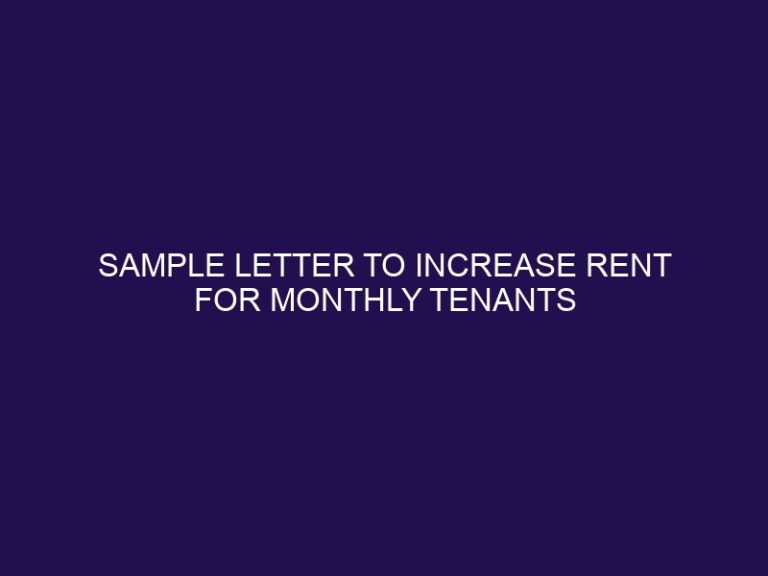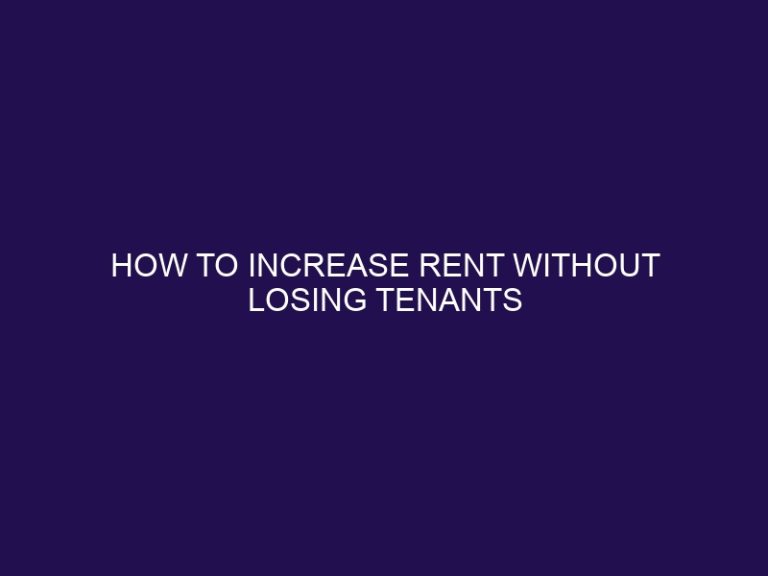Increasing Income with Pet-Friendly Rentals
With more and more people owning pets, allowing pets in rental properties has become a lucrative investment for landlords. In fact, according to a study conducted by the American Pet Products Association, around 85 million households in the United States own at least one pet. As a result, the demand for pet-friendly rentals has increased significantly, making it a wise investment decision for landlords.
Allowing pets in rental properties comes with various benefits, such as:
- Increased Demand for Pet-Friendly Rentals: With a large number of pet owners in the market, there is a high demand for pet-friendly rentals.
- Higher Rental Rates: Landlords can charge higher rental rates for pet-friendly properties due to the limited availability in the market.
- Longer Tenancy: By allowing pets, landlords are more likely to retain tenants for a longer period as it can be challenging for pet owners to find suitable accommodation.
- Less Vacancy: Landlords with pet-friendly rentals experience less vacancy as pet owners are willing to pay more and stay longer in a pet-friendly property.
However, concerns such as property damage, noise complaints, and liability for pet-related incidents may make landlords hesitant to allow pets in their rental properties. However, there are ways to mitigate these concerns and make your property pet-friendly.
Some ways to make your rental property pet-friendly are:
- Set Clear Pet Policies: Establishing clear guidelines and rules regarding pets in your property can help prevent any potential issues.
- Charge a Pet Deposit or Fee: Charging a pet deposit or fee can cover any potential damage caused by pets.
- Screen Potential Tenants and Their Pets: Conducting thorough screening of potential tenants and their pets can help you choose responsible and well-behaved tenants.
- Consider Pet Insurance: Encouraging or requiring tenants to have pet insurance can provide additional protection for your property.
To attract more potential tenants, landlords can also offer pet-friendly amenities, such as outdoor spaces, pet washing stations, and on-site pet services. These amenities can give pet owners peace of mind and make your property stand out in the market.
In conclusion, allowing pets in rental properties can benefit landlords by increasing income, attracting more tenants, and reducing vacancy rates. By taking necessary precautions and offering pet-friendly amenities, landlords can tap into this growing market and reap the benefits of pet-friendly rentals.
Why Pet-Friendly Rentals are a Good Investment?
Pet-friendly rentals are a wise investment due to the increasing demand for such properties. By allowing pets, landlords can attract a larger pool of tenants, decrease vacancy rates, and charge higher rents. For instance, a property owner in downtown Seattle experienced a 20% rise in rental income after implementing a pet-friendly policy.
Additionally, responsible pet owners have proven to be long-term and dependable tenants.
What are the Benefits of Allowing Pets in Rental Properties?
Are you a landlord or property manager considering allowing pets in your rental properties? In this section, we will discuss the benefits of opening your doors to furry companions. From increased demand for pet-friendly rentals to higher rental rates and longer tenancy, we will explore how welcoming pets can lead to financial gains for landlords. Additionally, we will touch on how allowing pets can help reduce vacancy rates and keep your rental properties occupied.
1. Increased Demand for Pet-Friendly Rentals
- Promote pet-friendly policies in property listings to accommodate the increased demand for pet-friendly rentals.
- Offer flexible lease terms for pet owners to make it easier for them to find a suitable rental property.
- Provide convenient access to pet services and amenities to cater to the needs of pet owners.
- Highlight nearby pet-friendly parks and facilities to make it easier for pet owners to find places to exercise and socialize their pets.
2. Higher Rental Rates
Higher rental rates for pet-friendly properties are a result of increased demand and limited supply. Landlords can take advantage of this trend by providing well-maintained, pet-friendly rentals with appealing amenities. Furthermore, conducting comprehensive tenant screenings can help mitigate risks associated with allowing pets.
3. Longer Tenancy
- Establish Clear Pet Policies to outline tenant responsibilities.
- Implement a Pet Deposit or Fee to mitigate potential damages.
- Screen Tenants and their Pets to ensure compatibility and responsibility.
- Consider Pet Insurance to safeguard against unforeseen incidents and encourage longer tenancy.
Pro-tip: Regular property inspections can help identify and address any pet-related issues early on, maintaining a positive landlord-tenant relationship.
4. Less Vacancy
- Implement appealing pet-friendly policies to decrease vacancy rates.
- Promote pet-friendly amenities such as dog parks and pet washing stations.
- Offer pet-related services like grooming or walking as additional benefits.
To decrease vacancy, consider creating a welcoming atmosphere for tenants with pets, and providing pet-related amenities that cater to their needs.
What are the Concerns of Landlords Regarding Pet-Friendly Rentals?
As more and more people consider their furry friends as part of the family, the demand for pet-friendly rentals has increased. However, for landlords, allowing pets in their properties can be a cause for concern. In this section, we will discuss the top concerns that landlords have when it comes to pet-friendly rentals. These include potential property damage, noise complaints from neighbors, and liability for any pet-related incidents. By addressing these concerns, we can better understand the challenges and benefits of offering pet-friendly rentals.
1. Property Damage
- Include pet-specific clauses in the rental agreement to address concerns regarding property damage.
- Conduct thorough property inspections before and after tenancy, carefully documenting any existing or new damages.
- Require renters with pets to provide a deposit specifically for potential repairs related to pet damage.
2. Noise Complaints
- Address noise complaints promptly through open communication with tenants.
- Enforce clear guidelines on pet noise and behavior through lease agreements.
- Consider soundproofing measures in rental units.
Did you know that 2. Noise Complaints are one of the top concerns for landlords in pet-friendly rentals?
3. Liability for Pet-Related Incidents
- To mitigate 3. liability for pet-related incidents, implement strict pet policies.
- For added protection, require renters to carry pet insurance.
- To minimize risks, enforce thorough pet screening procedures.
How to Make Your Rental Property Pet-Friendly?
Are you a landlord looking to make your rental property more appealing to pet owners? Making your property pet-friendly can not only increase your potential tenant pool but also potentially increase your income. In this section, we’ll discuss the steps you can take to make your rental property welcoming to furry friends. From setting clear pet policies to considering pet insurance, we’ll cover all the important aspects of creating a pet-friendly rental.
1. Set Clear Pet Policies
- Develop a comprehensive pet policy document.
- Incorporate guidelines for pet size, breed, and the maximum number of pets permitted.
- Define which areas of the rental property are accessible to pets.
- Outline the responsibilities related to pets for tenants.
2. Charge a Pet Deposit or Fee
- Evaluate the local rental market to determine competitive pet fees.
- Consider implementing a refundable pet deposit or a non-refundable pet fee based on the type of property.
- Clearly specify the amount of the pet deposit or fee in the lease agreement.
- Utilize pet fees to cover any potential costs for pet-related property maintenance.
3. Screen Potential Tenants and Their Pets
- Request a pet resume from potential tenants detailing the pet’s behavior, training, and vaccination records.
- Conduct a pet interview to assess the pet’s temperament and compatibility with the rental property.
- Verify pet ownership and registration to ensure accountability.
- Require a meet-and-greet between the pet and landlord to gauge interaction and behavior.
Did you know? By thoroughly screening potential tenants and their pets, you can ensure responsible pet ownership and reduce the risk of property damage.
4. Consider Pet Insurance
- Research pet insurance providers to find coverage suitable for rental properties.
- Consult with insurance agents to understand coverage options, including property damage and liability protection.
- Compare costs and benefits of different pet insurance plans to select the most suitable for your rental business.
Additionally, it is important to consider pet insurance for your rental properties. This will provide protection and coverage in case of any incidents involving pets on your property.
What are Some Pet-Friendly Amenities to Attract Tenants?
As the demand for pet-friendly rental properties continues to rise, landlords and property managers are looking for ways to attract and retain tenants with pets. In this section, we will explore some key amenities that can make your rental property stand out as a pet-friendly option. From outdoor spaces designed for pets to convenient on-site pet services, we’ll discuss the various ways you can cater to pet owners and increase your rental income.
1. Pet-Friendly Outdoor Spaces
- Provide plenty of green spaces for pets to play and get exercise.
- Incorporate pet-friendly amenities, such as dog parks or walking trails.
- Designate specific areas for pet relief and include waste stations for convenience.
- Ensure outdoor areas are secure with pet-friendly fencing and safety features.
2. Pet Washing Stations
- Designate an area with a drainage system for pet washing stations.
- Install a pet-friendly shower or bathtub with non-slip flooring.
- Provide pet-friendly shampoos and grooming tools for the convenience of pet owners.
- Offer towels or drying stations for pet owners to use after washing their pets.
Did you know? Pet washing stations can increase property desirability and attract more tenants.
3. On-Site Pet Services
- Pet grooming and spa services
- On-site veterinary care and pet health services
- Pet training and obedience classes
Frequently Asked Questions
What is the demand for pet-friendly housing in the United States?
The demand for pet-friendly housing in the United States is high, with organizations like Best Friends Animal Society receiving numerous inquiries about it each year.
Reference: Best Friends Animal Society
What percentage of landlords have no restrictions on the type of pets allowed in their rental properties?
Only about 9% of landlords in the United States have no restrictions on the type of pets tenants may own.
Reference: Best Friends Animal Society
How does allowing pets in rental properties affect profitability?
According to a 2011 analysis, pet-friendly landlords who place no restrictions on pet ownership can enjoy an 11.6% rental premium, leading to increased profits. Tenants with pets tend to stay longer, leading to lower vacancy rates and less time and money spent on advertising.
Reference: Best Friends Animal Society
Are there any valid concerns about allowing pets in rental properties?
The concerns about allowing pets in rental properties, such as noise complaints, messes, and damage to property, can be addressed by setting clear rules and guidelines for pet owners. Additionally, strict liability statutes hold dog owners responsible for their pets’ behavior, reducing liability issues for landlords.
Reference: Urban Surfaces
What is the average cost of damage caused by pets in rental apartments and houses?
The average cost of damage caused by pets in rental apartments and houses is only $191, which is relatively low compared to the potential increase in profits from allowing pets.
Reference: Urban Surfaces
How can allowing pets in rental properties attract more prospective renters?
Creating a pet-friendly environment can attract more prospective renters, as 93% of rental housing operators view pets as an important part of a family. Tapping into the large market of pet owners can also lead to a wider tenant pool and higher occupancy rates.
Reference: Urban Surfaces







